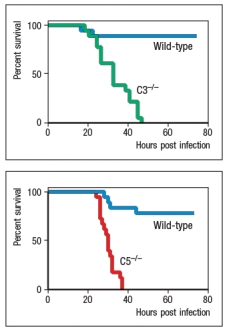Pseudomonas aeruginosa is a Gram-negative bacterium that causes severe, and often life-threatening infections in immunocompromised individuals. In susceptible individuals, P. aeruginosa can establish infections in a wide range of tissues, including the lung, the GI tract, the eye, the ear, the urinary tract, the skin, and the blood. This bacterium is common in the environment, and is found on the skin of approximately 5% of healthy individuals. It is often found on hospital equipment, such as ventilators and catheters, and as a consequence, P. aeruginosa accounts for ~10% of hospital-acquired infections. To study the role of complement in the early innate immune response to P. aeruginosa, the following studies in mice were performed. Mice deficient in complement C3 or C5 (C3-/- or C5-/-, respectively) were infected by intratracheal inoculation with 105 colony forming units (CFU) of P. aeruginosa, and survival was monitored over the first 72 hrs post-infection. The data from these studies are shown in Figure . Genetic data from human population studies also indicate that Individuals with genetic deficiencies in one of the collectins or ficolins show increased susceptibility to P. aeruginosa infections. 
a) Based on these data, evaluate the importance of complement in protection against P. aeruginosa infection, and describe the most likely complement pathway(s) involved in pathogen recognition and in pathogen destruction.
Another group of individuals that are highly susceptible to P. aeruginosa infections are patients with the disease cystic fibrosis. These individuals suffer from the production of a thick mucus secretion in their lungs, which clogs the bronchial tubes. A similar increase in viscosity of bodily secretions is seen in these patients' sweat, digestive fluid, and gastrointestinal mucus. In these patients, the most common form of lung infection is that of P. aeruginosa.
b) What is the most likely explanation for the increased susceptibility of cystic fibrosis patients to P. aeruginosa and other infections?
Definitions:
Manufacturing Overhead
The indirect factory-related costs that are incurred when a product is manufactured.
Forming Department
A section within a manufacturing process where raw materials are shaped or formed into parts before being assembled into final products.
Manufacturing Overhead
All indirect costs associated with the production process, such as utilities, maintenance, and factory supervisor salaries, not directly tied to the production of goods.
Customizing Department
A specialized department within a company focused on altering products to meet specific customer requirements or preferences.
Q7: A student asked a statistics professor if
Q9: Although the complement cascade can be initiated
Q15: The virus shown in the diagram below
Q16: Which of the two antibodies shown in
Q20: Based on these data, Fc
Q20: One clinical trial performed in the early
Q22: Several types of pathogens encode proteins that
Q29: Two different vaccines have been developed that
Q40: Given the following decision table in which
Q55: i. In a time series analysis, the